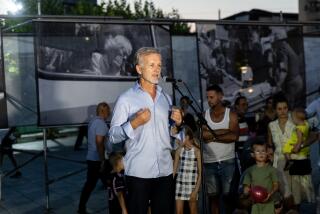Judge to Decide if Photographer From Times Must Testify at Trial
- Share via
Before testimony can begin in the civil case growing out of the bloody North Hollywood shootout that erupted after a botched bank robbery three years ago, a federal judge will decide if a Los Angeles Times photographer should be compelled to testify.
Carolyn Cole photographed bank robber Emil Matasareanu as he lay handcuffed in the street bleeding to death after he and an accomplice, both armed with automatic weapons, shot it out with outgunned police for 40 minutes.
Attorney Stephen Yagman, who is suing the city on behalf of Matasareanu’s two young sons, wants Cole to be his lead witness.
Cole, Yagman argued in federal court Tuesday, “had an unobstructed view [of Matasareanu]. She saw things not depicted on any videotape, and she heard things not heard by other people.”
However, Glen A. Smith, the lawyer representing Cole, moved Tuesday to quash or modify the subpoena seeking Cole’s testimony.
A federal common law privilege protects journalists from being forced to disclose unpublished information acquired during the news gathering process, Smith said in court documents.
“This privilege allows Ms. Cole to refuse to answer questions regarding her observations during and after the shootout,” Smith said in his legal motion.
Her testimony is unnecessary, Smith argued, because the only potential information she could provide would be to authenticate that she took the photograph published in The Times and several other newspapers across the country.
U.S. District Judge Christina A. Snyder scheduled arguments for today on Smith’s motion to quash Cole’s subpoena.
U.S. Magistrate Judge Rosalyn M. Chapman denied without prejudice a Yagman motion two years ago seeking to have Cole give sworn statements about what she saw and heard after the shootout.
Chapman said Yagman had failed to show that the information was unavailable despite exhausting all reasonable alternatives and had failed to show that the material was unique. Those tests must be met to allow an exception in the federal privilege for journalists.
Matasareanu and his accomplice, Larry Eugene Phillips, opened fire with their automatic weapons on officers who intercepted them after they had robbed a Bank of America branch at Laurel Canyon Boulevard and Archwood Street on Feb. 28, 1997.
When the shooting ended, Phillips lay dead by his own hand, and Matasareanu lay handcuffed and bleeding in the street. Eleven officers and seven civilians were injured.
Hovering television helicopters broadcast the chilling scenes live across the nation. The officers’ actions during the shootout were widely praised--by people ranging from ordinary citizens to President Clinton
The central question in this trial, though, is whether police and Fire Department personnel were deliberately indifferent to Matasareanu’s medical needs as he lay slowly bleeding to death in the street.
The suit has outraged police and public officials who say that the police behavior was exemplary as they faced down bandits wearing body armor and wielding automatic weapons while most of the officers had only 9-millimeter pistols.
Matasareanu, who had been shot 29 times, lay in the street for at least an hour slowly bleeding before he died, according to an autopsy report. The suit filed by Yagman alleges that the gunman’s civil rights were violated when Fire Department personnel failed to promptly give him medical attention.
Dr. Marshall Morgan, chief of emergency medicine at UCLA Medical Center, said Matasareanu, whose torso was protected by body armor, could have survived his wounds if only first aid had been given.
Morgan, who reviewed the autopsy report for a Times story, said none of the gunshot wounds appeared to be life threatening.
The autopsy report showed that 27 shots broke Matasareanu’s skin, including several in the thigh that caused the heaviest bleeding. However, bullets did not hit the femoral artery, the main blood supply to the legs.
Attorney Bradley C. Gage, who is defending retired LAPD Officer John Futrell, argued Tuesday that Morgan should be excluded from testifying as an expert.
Gage has said that Morgan “doesn’t have a sufficient foundational basis to express an opinion on what wounds were survivable.”
In denying Gage’s motion to exclude or limit Morgan’s testimony, Judge Snyder said that as head of emergency medicine at UCLA, Morgan is clearly qualified to testify on whether Matasareanu could have survived his wounds.
More to Read
Sign up for Essential California
The most important California stories and recommendations in your inbox every morning.
You may occasionally receive promotional content from the Los Angeles Times.












